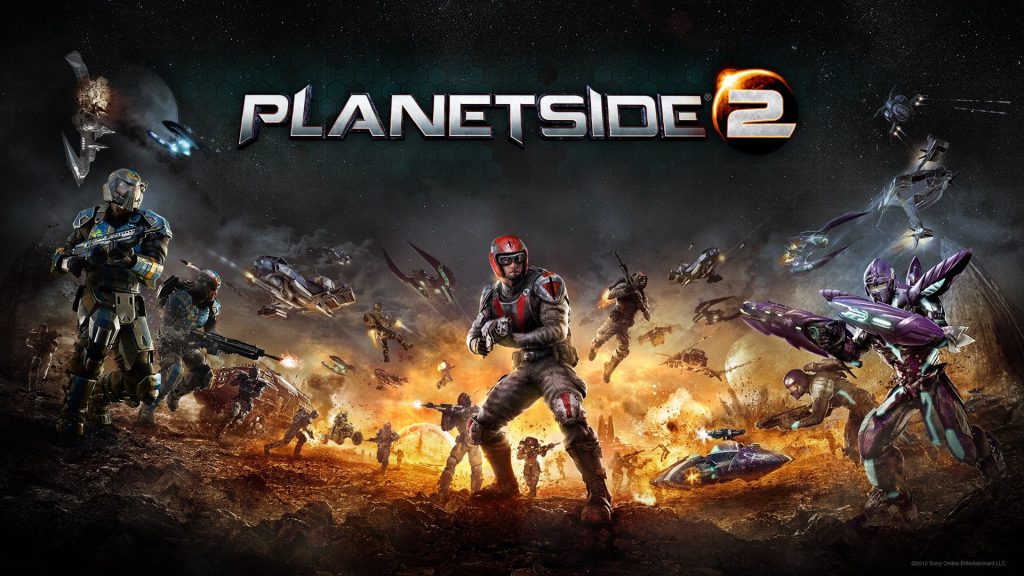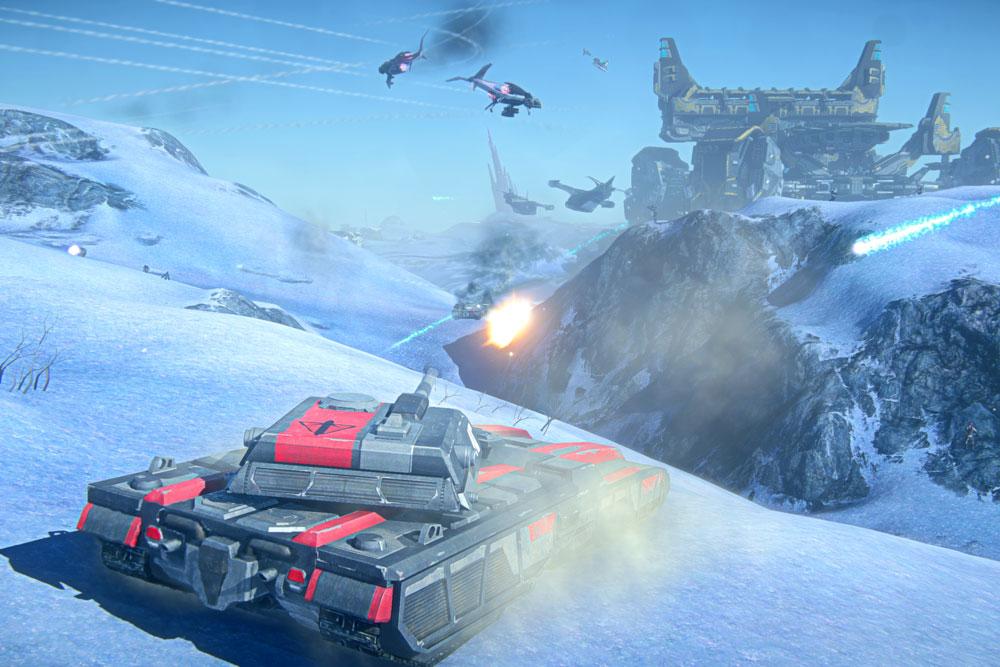I’m not a big fan of competitive online shooters, and even less so of the free-to-play business model – largely due to the ways in which this model is so frequently and grotesquely abused by greedy companies looking to fleece players – so the free-to-play massively multiplayer online first-person shooter (take a breath) PlanetSide 2 was far from a natural choice for me. However, intrigued by the prospect of participating in large-scale battles across a vast alien world, I decided to give it a shot, and I’m glad I did because it’s an enjoyable title that impresses on a number of fronts.
Developed and published by Daybreak Game Company (formerly Sony Online Entertainment), PlanetSide 2 is actually a remake of 2003’s PlanetSide rather than a true sequel, although this hardly seems to matter either way as PlanetSide 2 contains barely anything in the way of narrative, so players new to the series should have no concerns about jumping right in. Originally released on PC in 2012, PlanetSide 2 recently arrived on PlayStation 4 after several lengthy delays.
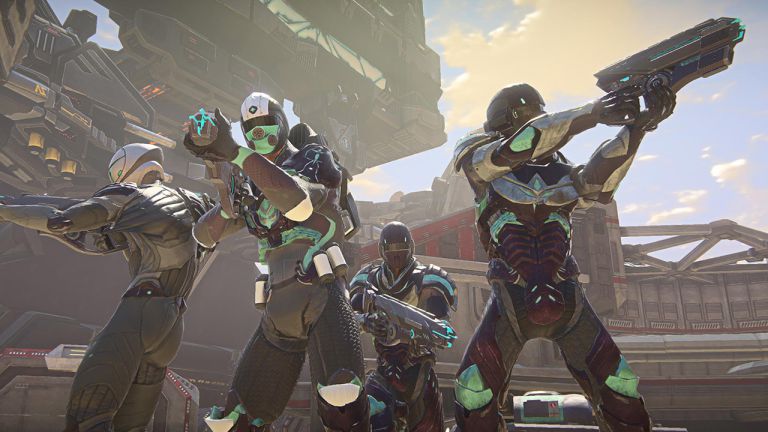
Taking place on the planet Auraxis, the game features three opposing factions, each fighting to claim Auraxis for themselves: the militaristic Terran Republic, the guerrilla fighters of the New Conglomerate, and the alien-technology-wielding Vanu Sovereignty. Each faction consists of several different types of infantry, ground vehicles and aircraft, although the exact nature of each of these unit types differs from faction to faction.
Once you’ve chosen a faction and name for your character (as well as the server you’re going to play on), you’re dropped onto Koltyr, the smallest of the five available continents, and pretty much left to figure things out on your own – one of PlanetSide 2’s most glaring flaws is its lack of basic guidance and information for new players, something which has no doubt caused some people to quit the game before giving it a proper chance. While this is a shame, in this situation the developers have no one to blame but themselves – I’m no fan of unnecessary hand-holding in a videogame, but there’s a big difference between that and delivering essential information that the player needs to know.
Your core aim in PlanetSide 2 is territory control, and there are no matches or modes here, no total victory or game over, just one constant war across the five continents of Auraxis: Koltyr, Amerish, Esamir, Indar, and Hossin. You can warp between these continents right from the start (although you’re locked out of Koltyr after your character reaches a certain rank), so you’re free to join in the fight wherever a battle may be taking place, and this is a great design decision – as the game itself tells you, if you’re not having fun in a particular battle, go and join a different one.
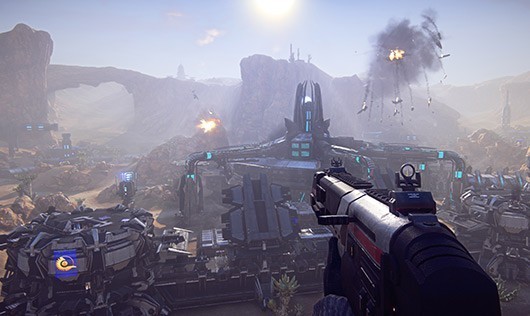
You have a map of each continent, and each map is overlaid with a colour-coded hexagonal grid showing which territories are currently controlled by which faction, and it’s your job to help capture enemy territories and expand your faction’s empire. You do this by capturing the bases and other structures within these territories – hold an enemy-controlled area for a certain amount of time and it becomes yours. Naturally this often leads to a tug-of-war-type situation where opposing forces come into conflict over an area, the battle shifting back and forth until one side manages to outfight the other and claim the contested territory.
So PlanetSide 2 is essentially a never-ending “King of the Hill” match between three factions consisting of hundreds of players each, and while this certainly has the potential to become repetitive over time (“War never changes” – it certainly doesn’t on Auraxis), especially if you play the game in long stretches or keep dying over and over at the same battle site, the game offers enough variety in other areas that this isn’t really a critical problem.
For example, you can swap between different character classes at terminals in the game-world, and each class is distinct enough that the player is offered a good degree of freedom in terms of play-styles. You’ve got Infiltrator, who specialises in stealth, sniping and reconnaissance; Medic, whose focus is on healing and reviving teammates; Light Assault, whose jetpack is great for quickly traversing obstacles and getting the drop on enemies; Engineer, a technology-focused class who can repair vehicles and other objects while also deploying turrets; Heavy Assault, intended for frontline combat and armed with a rocket launcher; and finally, “MAX”, which grants your character a heavily armed – and armoured – exoskeleton.
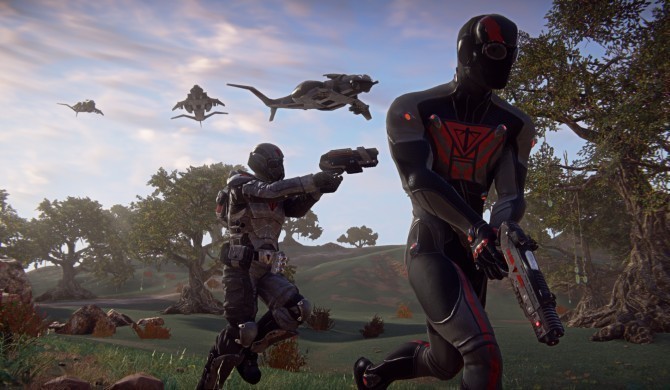
Although the bases and other structures you capture are often quite uniform and bland in design, the natural scenery fares better, the game utilising different types of landscapes for different continents: Amerish and Koltyr feature rolling hills and fields covered in green grass and rocky outcroppings; the desert-like continent of Indar is a more arid land; Hossin is largely covered in swamps and jungles; and Esamir is a continent of snow-covered plains and frozen rivers, with giant crystalline formations erupting from the ground.
The different landscapes and ability to warp between them means that a change of scenery is usually no more than a few button-presses away, and the game impresses not just in the vast size of these continents but also in atmospheric details such as the haze that hangs in the air in the jungles of Hossin, and the “northern lights”-style light displays that appear in the skies of Esamir at night. Just try not to get your spleen shot out while you’re staring at the pretty sights instead of focusing on the war.
While PlanetSide 2’s day / night cycle is a lengthy and well-implemented one, it does tie into one of the game’s problems, which is how difficult it can sometimes be to tell the difference between friendly and enemy soldiers, a problem which is only exacerbated when darkness falls. Friendly fire can’t be switched off, and that moment of hesitation when you spot a soldier in the distance but are unable to tell if it’s a hostile one can easily get you killed.
The music and sound of PlanetSide 2 are decent but unremarkable. The former is used sparingly, and when it is, it’s the kind of dramatic, military-infused music you might expect. Sound effects are serviceable, and you can also choose from a selection of predefined phrases for your character to say – useful should you want to thank someone, call out for aid, compliment a fellow soldier’s severed-ear necklace, etc. (Full voice-chat is also available, although you can mute all other players if you prefer).
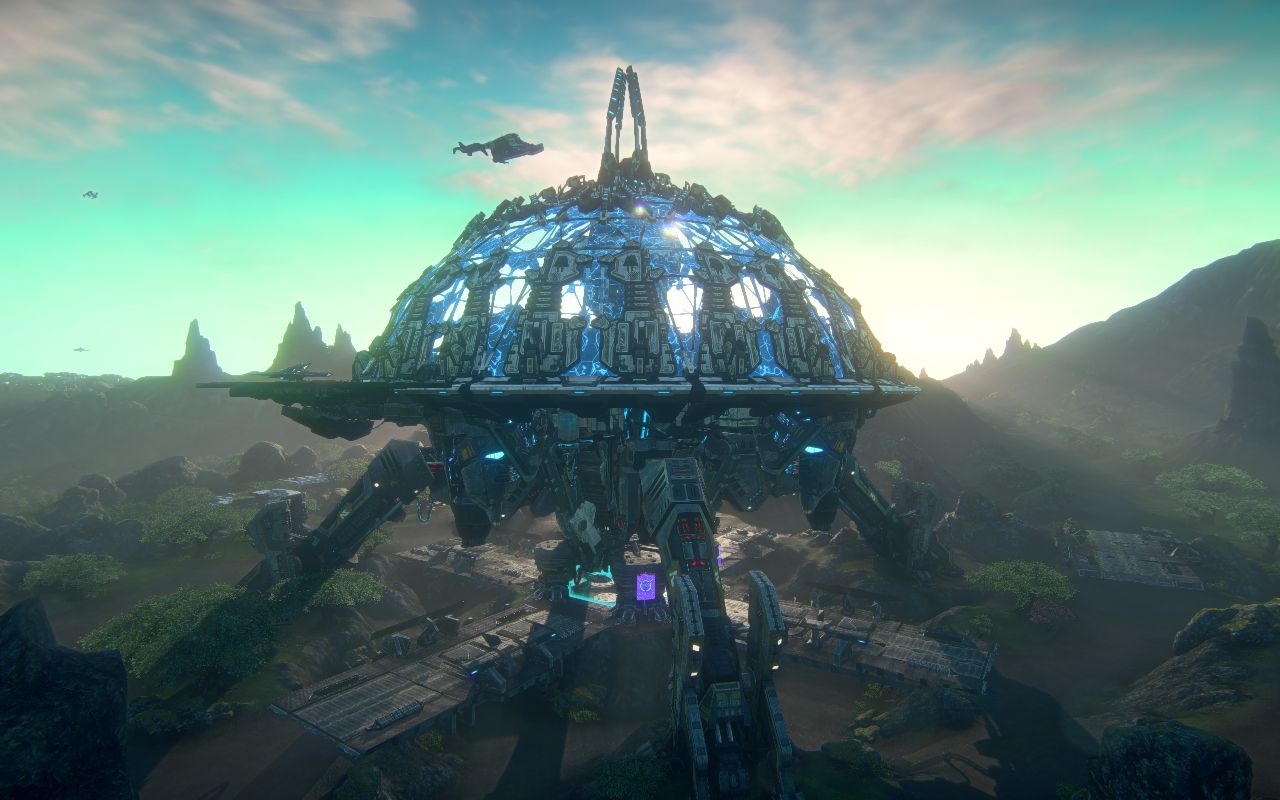
The controls while on-foot are fine and are laid out in a fashion similar to many console-based first-person shooters, but the vehicle controls are poor in comparison, being unnecessarily awkward and unintuitive, perhaps the worst offender being the controls when piloting an aircraft. You can get used to them with time and practice, of course, but that doesn’t necessarily make them any more fun. After trying out a few vehicles, I was quite happy to then ignore them and focus on playing on-foot.
Considering the sheer size of the game-world and the often massive number of players involved at any one time, I was pleasantly surprised to discover that PlanetSide 2 performed excellently during almost the entire time I played it – while I was expecting moments of lag, slow-down, etc., the game actually ran very smoothly for me. The only glitch I encountered was when a temporary notification (experience points earned from an action, for example) would remain on the screen rather than disappearing as it was supposed to. This happened a handful of times and could only be rectified by restarting the game, but I never lost any progress when doing so, so it wasn’t a big deal.
And so we come to the chosen business model of PlanetSide 2: free-to-play. Thankfully its implementation in the game is a far cry from free-to-play abominations such as Dungeon Keeper Mobile – I’ve spent over a dozen hours with PlanetSide 2 and not once has it plastered any obnoxious advertising across the screen, stopped me from playing and made some kind of forced attempt to get me to spend real-world money to continue, or made me feel like I was at a significant disadvantage compared to other players who had spent money on the game.
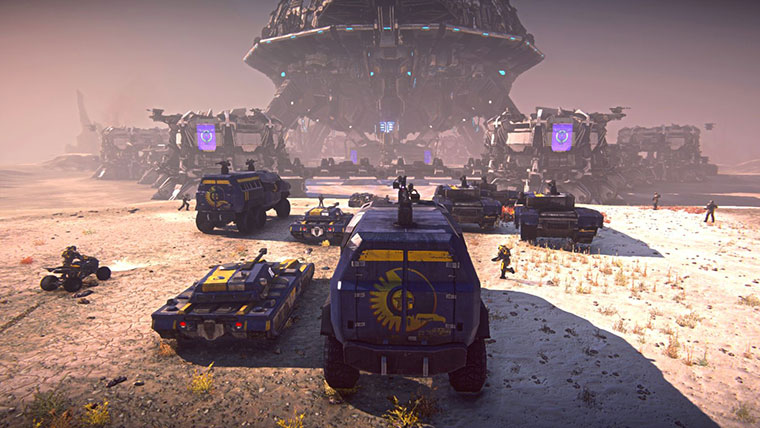
As you earn experience by killing enemies, capturing territories and performing various other actions, you gradually increase your character’s rank, and in doing so you unlock further classes, vehicles and equipment slots, which you can purchase with the currency earned alongside your experience – there’s plenty of enjoyable content here and it doesn’t cost you a penny.
However, weapons, upgrades and cosmetic items such as different camouflage patterns and helmets can only be bought with a separate currency, one which must be paid for with real-world money (which can also be used to purchase subscriptions of varying length, granting increased experience gain and other bonuses while valid). As such, there is certainly a sizeable amount of content cut off from players who don’t want to spend any money, but again, this makes the game no less enjoyable in my experience, so it would seem that Daybreak Game Company have managed to reach an impressive balance with their business model. Kudos to them.
PlanetSide 2 is an unnecessarily unwelcoming and potentially frustrating game when you first dive into it, and it can certainly take a while for the game to click with the player, if it does at all. For me, this only really happened after several hours, during my first visit to the frozen continent of Esamir, when I and several dozen teammates were fighting against a similarly large enemy force in a contest to take control of a bridge and the base standing at one end of it. This large-scale battle raged across the base, the bridge, the frozen river beneath it, and the snow-covered fields lining the river, with gunfire and explosions filling the air and illuminating the darkness of the night as numerous infantry types and vehicles fought tooth-and-nail.
Eventually, after a long battle, my faction captured the bridge before quickly being assigned the task of capturing another facility nearby. I took a moment to enjoy the victory and watched as dozens of my teammates, on-foot and in vehicles, rolled out across the tundra as one large force. I joined them and we went on to capture several more territories, one after the other, crushing our enemies and seeing them driven before us (but without hearing the lamentations of their women).
The battle for that bridge and the consecutive battles that followed really cemented my appreciation for PlanetSide 2, and I’ve spent a number of enjoyable hours with it since then. The core gameplay is fun and while inherently simple, the game offers enough variety to keep things interesting, and can provide some truly memorable and thrilling moments when the circumstances are right.
But don’t take my word for it, find out for yourself – with an entry fee of “absolutely nothing”, it would be rude not to. War may be hell, but PlanetSide 2 is war with jetpacks, and that’s a beautiful thing. Jetpacks are great.
Rating – 8 / 10
Emily Medlock is an avid gamer whose passions not only include video games of all kinds, but anime, music, movies, and reading.

